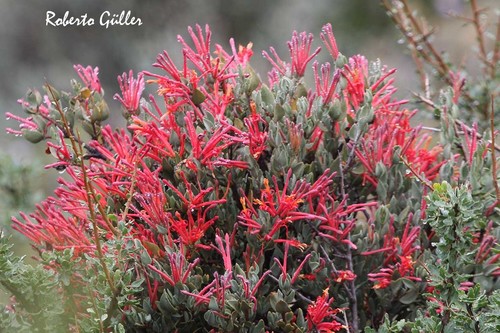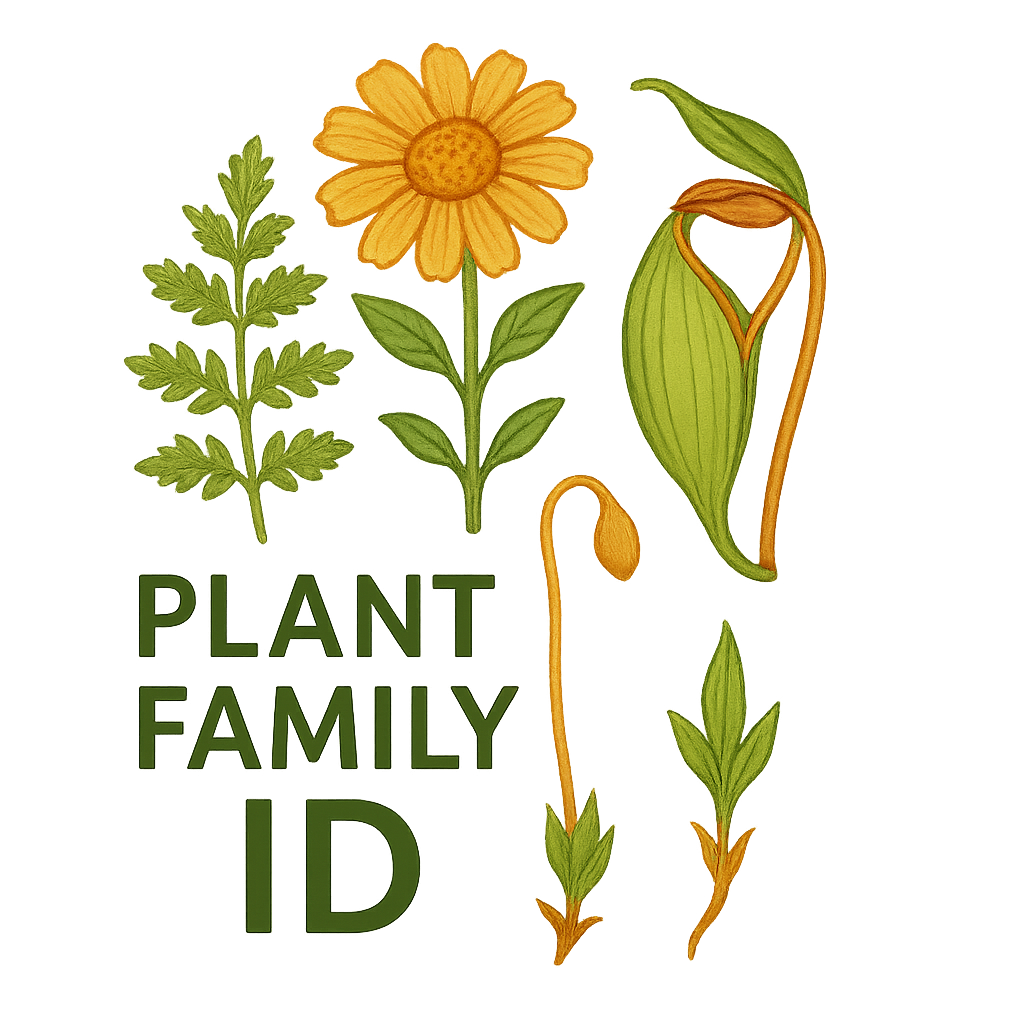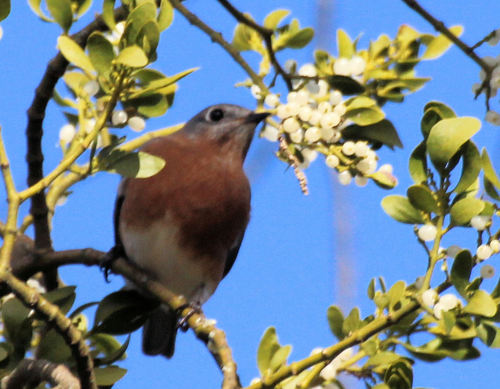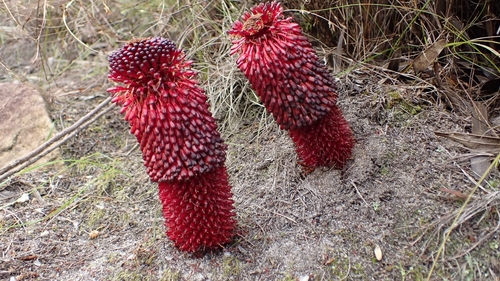Loranthaceae
Showy Mistletoe Family
Loranthaceae is a large family of flowering plants commonly known as the showy mistletoes. Its members are primarily aerial hemiparasites – they grow on the branches of trees and shrubs, photosynthesize, but draw water and mineral nutrients from their host via specialized structures called haustoria. The family is cosmopolitan but most diverse in the tropics, subtropics, and the Southern Hemisphere. It belongs to the order Santalales.

Overview
Loranthaceae is the largest family within the order Santalales, comprising about 70-80 genera and nearly 1000 species. These plants are defined by their parasitic lifestyle, typically growing attached to the branches of host trees or shrubs. As hemiparasites, they possess chlorophyll and perform photosynthesis but rely on their host for water and dissolved minerals, absorbed through invasive root-like structures called haustoria that penetrate the host's vascular system. While most are aerial stem parasites, a few rare species parasitize roots.
The family is distributed worldwide, with centers of diversity in tropical regions of Africa, Asia, Australia, and the Americas, as well as temperate areas of the Southern Hemisphere. They play significant ecological roles as food sources (fruits, nectar) for birds and other animals, and can impact host tree health, sometimes significantly in heavy infestations. Many species have large, brightly colored flowers adapted for pollination by birds (ornithophily). The fruits are typically berries dispersed by birds, containing seeds coated in a sticky substance called viscin.
Historically, the concept of "mistletoe" included this family and the related Viscaceae (now often included in Santalaceae). Loranthaceae generally have larger, more colorful flowers and often more developed leaves compared to the typically smaller, greener-flowered mistletoes of the Santalaceae alliance.
Quick Facts
- Scientific Name: Loranthaceae
- Common Name: Showy Mistletoe Family
- Number of Genera: Approximately 70-80
- Number of Species: Approximately 900-1000
- Distribution: Cosmopolitan, especially tropics, subtropics, and Southern Hemisphere.
- Habit: Primarily aerial hemiparasites on woody hosts.
- Evolutionary Group: Core Eudicots (Superasterids) - Santalales
Key Characteristics
Growth Form and Habit
Predominantly shrubby aerial hemiparasites growing on the branches of trees and shrubs. Attachment to the host is via one or more specialized structures called haustoria, which penetrate the host tissues. Stems can be erect, spreading, or pendulous, sometimes brittle. Rarely terrestrial root parasites.
Leaves
Leaves are usually arranged oppositely, but sometimes alternate or whorled. They are typically simple, with entire (smooth) margins, and often thick, leathery (coriaceous), or somewhat succulent in texture. Stipules are absent. In some genera, leaves may be reduced to small scales.
Inflorescence
Inflorescences are variable, including cymes, racemes, spikes, or heads, and are often axillary or terminal. Flowers are frequently arranged in pairs (dyads) or groups of three (triads), which are often subtended by bracts.
Flowers
Flowers are often relatively large, showy, and brightly colored (commonly red, orange, yellow, sometimes green or white), reflecting adaptation to bird pollination. They are usually bisexual (sometimes unisexual), mostly actinomorphic (radially symmetrical) but can be slightly zygomorphic. Typically (4-)5- or 6-merous:
- Perianth: Usually differentiated into calyx and corolla.
- Calyx: Highly reduced, forming a small rim, cup, or teeth at the apex of the inferior ovary, known as the calyculus.
- Corolla: Composed of (4-)5-6 petals, which can be free or fused basally into a tube (sympetalous). Petals are often long, tubular, and brightly colored. The corolla tube may sometimes split open along one side as the flower matures.
- Androecium: (4-)5-6 stamens, positioned opposite the petals (epipetalous). Filaments are attached to the corolla tube or the base of the petals. Anthers typically open via longitudinal slits.
- Gynoecium: The ovary is distinctly inferior, usually composed of 3-4 fused carpels. It typically contains a single locule without clearly differentiated ovules; instead, ovular tissue is embedded within a central placental column known as the mamelon. A single style extends upwards, topped by a small stigma.
Fruits and Seeds
The fruit is typically a fleshy berry (less often a drupe), often brightly colored (e.g., red, yellow, white, black) to attract birds. It contains a single seed (rarely more) which is surrounded by a layer of extremely sticky, translucent material called viscin. When birds consume the fruit and excrete the seed, the viscin layer allows the seed to adhere firmly to the host tree's branch, facilitating germination and haustorial penetration.
Chemical Characteristics
Plants may sequester compounds from their hosts. Some produce polyacetylenes or other secondary metabolites, but they are not generally known for potent toxins like Loganiaceae.
Field Identification
Identifying Loranthaceae primarily involves recognizing their parasitic habit and associated features:
Primary Identification Features
- Aerial parasitic habit: Look for shrubby plants growing directly on the branches of trees or larger shrubs.
- Haustorial connection: Observe the point of attachment to the host branch, often appearing as a swollen or distinct connection point (haustorium).
- Opposite, leathery leaves (usually): Check for pairs of simple, entire leaves, often thick or leathery.
- Showy flowers (often red/orange/yellow): Flowers are frequently large, tubular, brightly colored, and adapted for bird pollination.
- Inferior ovary with calyculus: The ovary is below the petals, topped only by a small rim or cup (calyculus) instead of prominent sepals.
- Berry fruit with sticky viscin: Look for fleshy berries; crushed ripe berries will reveal the sticky viscin surrounding the seed.
Secondary Identification Features
- Epipetalous stamens: Stamens are attached to the petals or corolla tube.
- Flower symmetry: Mostly actinomorphic, sometimes slightly zygomorphic or curved.
- Flower parts in 5s or 6s (commonly): Count petals and stamens.
Seasonal Identification Tips
- Year-round: The parasitic habit and often evergreen leaves make them visible throughout the year. Haustorial connections are always present.
- Flowering Season: Varies greatly by species and location, often timed to attract specific bird pollinators. This is the best time to observe floral characteristics.
- Fruiting Season: Berries develop after flowering and are crucial for observing the viscin layer.
Common Confusion Points
Distinguishing Loranthaceae from other mistletoes and epiphytes:
- Santalaceae mistletoes (incl. former Viscaceae - e.g., Viscum, Phoradendron): Also aerial parasites, but typically have smaller, less conspicuous, often greenish or yellowish unisexual flowers with tepals (not distinct calyx/corolla). Ovary position varies (inferior or superior). Leaves often smaller or reduced to scales.
- Epiphytes (e.g., Orchids, Bromeliads, some Ferns): Grow on host branches but are not parasitic; they derive no nutrition from the host. They lack haustoria and typically have distinct root systems for anchorage and absorption from the air/rain/debris. Their flower and fruit structures are entirely different.
Field Guide Quick Reference
Look For:
- Aerial parasite on woody host
- Haustorial connection
- Usually opposite, leathery leaves
- Showy, often colorful flowers (red/orange/yellow)
- Inferior ovary
- Reduced calyx (calyculus)
- Fleshy berry fruit
- Sticky viscin layer around seed
Key Variations:
- Flower color and shape
- Leaf size and shape (or reduced to scales)
- Number of flower parts (4, 5, or 6)
- Petals free or fused
- Inflorescence type
Notable Examples
This large family includes many genera with diverse appearances across the globe:

Amyema spp.
(Australian Mistletoes, in part)
A large genus found primarily in Australia, Southeast Asia, and the Pacific islands. Species exhibit a wide range of flower colors (often red, orange, or green) and host preferences. They are ecologically important in Australian ecosystems.

Psittacanthus spp.
(Parrot Mistletoes)
A genus of robust mistletoes found in the Neotropics (Central and South America). They often have large, very showy red, orange, or yellow tubular flowers adapted for hummingbird pollination. Leaves are typically large and opposite.

Agelanthus spp.
(African Mistletoes, in part)
A significant genus of mistletoes found across Africa. Species often have brightly colored tubular flowers, frequently yellow, orange, red, or pink, often pollinated by sunbirds. They parasitize a wide variety of host trees.

Struthanthus spp.
(Vine Mistletoes)
Another large Neotropical genus, often characterized by smaller, less conspicuous greenish or yellowish flowers compared to Psittacanthus. Many species have a more vine-like or sprawling habit with extensive haustorial connections along host branches.
Phylogeny and Classification
Loranthaceae belongs to the order Santalales, a group characterized by its high prevalence of parasitism (ranging from hemi- to holoparasitism). This order is placed within the Superasterids, a major clade of Core Eudicots, but it is distinct from the Asterids sensu stricto (which includes orders like Asterales, Lamiales, Gentianales).
Loranthaceae is the largest family in the Santalales. Molecular phylogenetics has clarified its relationships with other families in the order, confirming its distinction from Santalaceae (which now includes the former Viscaceae and Eremolepidaceae). Key features supporting its monophyly include the inferior ovary, the presence of a calyculus, and often large, bird-pollinated flowers.
Position in Plant Phylogeny
- Kingdom: Plantae
- Clade: Angiosperms (Flowering plants)
- Clade: Eudicots
- Clade: Core Eudicots
- Clade: Superasterids
- Order: Santalales
- Family: Loranthaceae
Evolutionary Significance
Loranthaceae represents a major radiation of aerial parasitic plants and is significant for:
- Evolution of parasitism: Provides insights into the adaptations required for an aerial hemiparasitic lifestyle, including haustorial development and host interactions.
- Co-evolution with pollinators: The often large, colorful flowers demonstrate strong co-evolutionary relationships with bird pollinators (ornithophily), especially hummingbirds and sunbirds.
- Co-evolution with dispersers: The sticky berry fruit is a classic adaptation for dispersal by frugivorous birds, ensuring seeds are deposited on suitable host branches.
- Biogeography: Its global distribution, particularly strong presence in Gondwanan landmasses (Australia, South America, Africa), provides clues about ancient continental connections and dispersal events.
- Ecological impact: Mistletoes can significantly influence forest structure, nutrient cycling, and provide resources for wildlife, acting as keystone species in some ecosystems.



